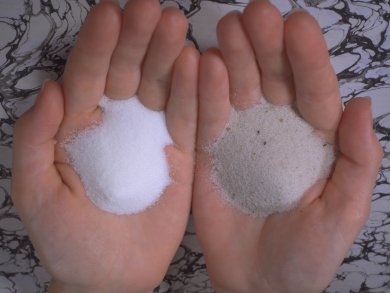Sugars: Cans and Can’ts
In order for enzymes and other proteins in our bodies to work correctly, it is often necessary for multiple protein units to gather together into a larger structure. Chains of sugar molecules cannot do this—at least that is what was thought until now. A team led by Thomas Heinze, University of Jena, Germany, and Stephen E. Harding, University of Nottingham, UK, has now proven the opposite. In the journal Angewandte Chemie, the researchers have introduced their discovery: cellulose-like carbohydrates that can form defined aggregates from several subunits.
The individual protein subunits of functional proteins are not chemically bound to each other; they are held together by physical attractive forces and can separate again depending on the environmental conditions. It was previously assumed that molecules made of many sugar units, known as polysaccharides, never demonstrate such behavior. Defined, reversible aggregates of several such sugar chains have not previously been observed. The German–British team of researchers has now detected the protein-like aggregation of carbohydrates into defined oligomers—a novel and completely unexpected phenomenon.
Aggregating Aminocelluloses
The scientists studied a nitrogen-containing polysaccharide that resembles cellulose. Cellulose is the primary component of plant cell walls and is the most familiar representative of the polysaccharide family after starch. The researchers examined aminocelluloses by means of analytical ultracentrifugation. Ultracentrifuges rotate up to 500,000 times a minute. The correspondingly high centrifugal forces cause large molecules to sediment, or settle to the bottom. The sedimentation rate can be used to determine the approximate molar masses of macromolecules. In their study, the researchers found up to five different species present in their aminocellulose solutions. Their molar masses were found to be multiples of the mass of the monomer, clearly showing that they are aggregates of two to five polysaccharide units. The aggregates dissociate when the solution is diluted, indicating that the bonds are reversible.
The researchers believe that aminocelluloses not only interact with each other in this way, but also with certain other biomolecules. They could thus be interesting as boundary surface materials with biological recognition functionality, which could be used to immobilize proteins, for example to design analysis devices outside a lab to identify toxins or pathogens within a few minutes. These are interesting for the on-site detection of animal diseases, food contamination as well as of biological warfare agents such as anthrax, ebola, and botulinus toxin.
- Protein-Like Oligomerization of Carbohydrates
T. Heinze, M. Nikolajski, S. Daus, T. M. D. Besong, N. Michaelis, P. Berlin, G. A. Morris, A. J. Rowe, S. E. Harding,
Angew. Chem. Int. Ed. 2011.
DOI: 10.1002/anie.201103026




